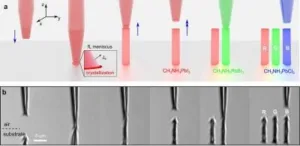A team of researchers led by Mojun Chen within the Department of Mechanical Engineering at Hong Kong University along with team members from the Korea Electrotechnology Research Institute (Changwon-si, South Korea) have reported success in using 3D printing to create nanosized display pixels made of perovskite.

First a few words of background information.
Although perovskites have many highly favorable properties, there are currently technical difficulties that prevent their fabrication into high resolution, free form structures. More specific to this article, the use-cases of perovskites are currently limited by a lack of 3D production methods. This, in turn, has put a damper on the use of perovskites in applications that include innovative optoelectronic devices.
Prior research by the team has demonstrated that the brightness of 3D printed perovskite nanopixels increases with the height of the nanopixel. It follows, therefore, that, up to now, precise control of print height has been required to assure brightness uniformity across all nanopixels in an array of 3D printed nanopixels. In practice, this has proven difficult to achieve.
In their current work, the team has undertaken research to address this issue. A recent article published on this topic by the team is entitled “Three-Dimensional Perovskite Nanopixels for Ultrahigh-Resolution Color Displays and Multilevel Anticounterfeiting.” It appears in Nano Lett. 2021, 21, 12, 5186-5194 on June 14, 2021. A copy of the article is available for purchase and can be found here.
The basic approach adopted by the team was to 3D print the pixels to heights that exceeded the heights at which the brightness of the emissions were found to saturate. Although simple, this approach serves to minimize the need for precise control of the height of individual pixels.
Further details on the means by which this is accomplished are as follows. A nanopipette was used to 3D print a meniscus comprising femtoliters of one of three colors of perovskite based ink. This served to guide a highly confined, out-of-plane crystallization process. A graphic illustration of the deposition process is presented in the figure below.
3D printing of perovskite nanopixels using a nanopipette. Different chemical compositions enable the fabrication of red, green and blue pixels.
With these prototypes, the team demonstrated that the 3D form of the nanopixels could enable full color perovskite based pixels with programmed dimensions and placements as well as improved brightness – all accomplished without sacrifice in lateral resolution.
In terms of applications, one of the most immediate uses of the new technology is in high resolution optical displays. In one such application, the 3D printed nanoscale perovskites could be used to filter color in a backlit display device. The team is now investigating means to transition from passive illumination to electrically driven, controllable lighting devices based on 3D printed perovskite pixels.
The researchers conclude their article with the statement that the proof-of-concept devices reported in their paper “demonstrate the potential of 3D printing to become a platform for the manufacture of smart, high performance photonic devices without design restrictions.” – Arthur Berman
Korea University of Science and Technology, Jaeyeon Pyo, [email protected]

